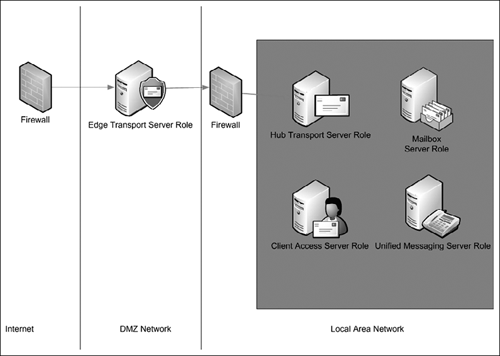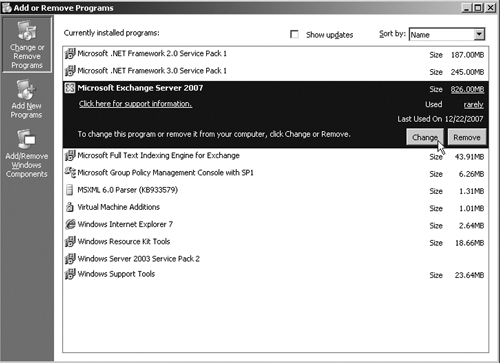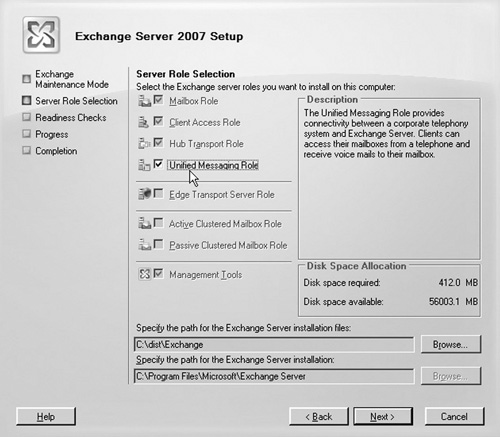Solutions in this chapter:
In this chapter, we will explore Unified Messaging (UM) and how to integrate Exchange 2007 UM with Office Communications Server (OCS) 2007. I will provide a high-level overview of Exchange 2007 UM and cover how to integrate OCS 2007 with an existing Exchange 2007 UM deployment.
UM is an exciting new feature in Microsoft Exchange Server 2007. UM provides the ability to unify your various mailboxes including e-mail, voice mail, and fax. Exchange 2007 UM brings many of the traditional voice mail features to e-mail in the same way OCS brings Private Branch Exchange (PBX) features to instant messaging (IM).
Exchange 2007 UM allows you to access your voice mail, e-mail, and faxes all from a single inbox via your Outlook 2007 client or even Outlook Web Access. Exchange 2007 UM also incorporates a feature known as Outlook Voice Access (OVA), allowing end-users to access their voice mail, e-mail, and even Outlook calendar via any telephone. OVA uses voice recoginizition technology to perform commands based on the spoken voice. For example, OVA allows you to call Exchange and enter your mailbox number and passcode just as you would typically access voice mail remotely. However, with OVA you can access new voice mail messages by simply speaking into the phone the words voice mail. OVA will then play any new voice mails waiting in your inbox. Alternatively, you can simply launch your Outlook client and listen to voice mails through your computer speakers.
UM works by integrating Exchange Server 2007 with your existing PBX phone system. Connectivity between the PBX and Exchange Server 2007 typically involves a Voice over IP (VoIP) gateway device linking the two systems. The VoIP gateway accepts unanswered incoming calls from the PBX and routes them to the appropriate Exchange mailbox to allow the caller to record a voice-mail message. The VoIP gateway also accepts incoming Outlook Voice Access calls from the PBX. To make this clearer let’s walk through a couple of examples.
First, let’s take a look at voice-mail. A caller picks up the phone and dials your phone number. The call comes inbound to your PBX and is routed to your phone and it rings. If you do not answer your phone in a predetermined amount of time, the PBX routes the call to the VoIP gateway. The VoIP gateway then hands the call over to the Exchange UM server. The UM server will then record the voicemail for the intended receipt. Next the Exchange UM server will send the voicemail to the hub-transport server which will in turn route the voicemail to the correct mailbox on the mailbox server.
Great, you now have a new voice mail. However, we’ll pretend you’re at a client location with no Internet access. So, how do you check your voice mail? Remember, that message no longer resides in a tradition voice-mail system; instead, it’s waiting for your review in your Exchange mailbox. No problem. You pull out your cell phone and dial the OVA number. You then enter your mailbox number and pin code. OVA then presents you with a menu of options. You simply say voice mail and OVA begins to play the new voice-mail message. After hearing the voice-mail message, you decide you need to check your calendar. You speak into the phone, saying the words calendar for today. OVA opens your calendar and speaks your appointments for today over the phone.
The preceding were just a couple of examples of Exchange 2007 UM features and how you can use them in the real world. Next, we’ll discuss in a little more in detail the requirements to implement Exchange 2007 UM.
Exchange 2007 UM has a few requirements to work properly. Exchange UM, in most cases, will require a VoIP gateway installed. These can range from around a thousand dollars to several thousand dollars, depending on the capacity required. The VoIP gateway is needed to route traffic between a traditional PBX and Exchange 2007. By implementing a VoIP gateway, you can integrate most phone systems with Exchange 2007. Depending on your PBX vendor, you may not need to implement a gateway device. Some IP based PBXes provide integration with Exchange 2007 out of the box or with an add-on to their software. The main requirement is that they can route IP-based calls using the SIP protocol. These types of PBXes are then configured to route SIP-based calls bound for OCS users to the OCS mediation server.
Implementing UM requires a properly architected and implemented Exchange 2007 infrastructure. In most cases, you will need to be sure that not only Exchange but also Exchange connectivity to your PBX is highly available. With all of the great features provided by Exchange UM comes the risk of “putting all your eggs in one basket.” Traditionally, if you lost your e-mail system, voice mail would still be available, or vice versa. However, after implementing Exchange UM, if your e-mail system goes down, so does your voice mail. This is why it’s important to ensure that you properly design your Exchange environment before you deploy. If you require 99% uptime, you had better plan accordingly.
To properly implement Exchange 2007 UM, it is important to understand how Exchange is architected and deployed. Implementing Exchange 2007 is somewhat different than Exchange 2003. You will remember that implementing Exchange 2003 required installing all Exchange components, then disabling those that were not needed, and then properly configuring a server to provide a specific service. For example, after installation you must properly perform a series of configuration steps to designate that server as a front-end server. Exchange 2007 introduces a concept known as server roles. Server roles allow you define a server’s purpose before installing Exchange. By doing so, only the components needed to perform that specific function are installed. Exchange 2007 incorporates five server roles, each performing a particular function (See Figure 10.1).
Before you jump in and deploy Exchange, it is important to understand the necessary requirements, both hardware and software. The biggest difference between Exchange 2007 and the previous version of the messaging system is that it requires 64-bit processors and a 64-bit version of Windows. You can install Exchange 2007 on Windows Server 2003 Standard or Enterprise. Service Pack 1 for Exchange 2007 provides the capability to install Exchange on a Windows Server 2008 system as well. If you plan to use UM, you will need to make sure you have a compatible IP-PBX or a VoIP gateway that will provide connectivity between Exchange and your PBX.
We previously discussed the new server role concept in Exchange Server 2007. You can install Exchange 2007 as five distinct roles, each designed to perform a specific function. Keep in mind that server roles do not necessarily mean that separate physical servers are required for each role. For example, you can deploy an Exchange server with both the Mailbox server role and the Client Access server role. Let’s briefly cover each role and its purpose in an Exchange 2007 deployment.
The Mailbox server role in Exchange Server 2007 is where mailboxes for users are stored. The Mailbox server role in Exchange 2007 is synonymous with a back-end server in Exchange 2003. A mailbox server role must exist in an Exchange 2007-only server environment. The Mailbox server role can exist on the same physical server as other server roles.
The Hub Transport server role performs the task of internal message routing and encryption. The Hub Transport server role also is in charge of applying internal policies on message routing. The Hub Transport server role can exist on the same physical server as other server roles.
The Client Access server role in Exchange 2007 is similar to the front-end server in Exchange 2003. The Client Access server role provides Outlook Anywhere Access, formally known as Outlook Web Access and HTTP/RPC. The Client Access server role also supports connectivity for Windows Mobile devices. The Client Access server role can exist on the same physical server as other server roles.
The Edge Transport server role resides in the DMZ of your network and is not a domain-joined server. The Edge Transport server role is in charge of external SMTP connectivity and provides antivirus, antispam, and encryption services for messages received from or destined to the Internet. You cannot install the Edge Transport server role on the same server as other roles, as it should reside in the DMZ of your network.
The Unified Messaging server role is necessary if you plan to provide UM services in your Exchange deployment. The Unified Messaging server role provides connectivity between the VoIP gateway and your Exchange 2007 infrastructure. Though not recommended in most production environments, you can install the Unified Messaging server role on the same physical server as other server roles.
Now that you are familiar with the Exchange 2007 architecture basics, it’s time to set up and configure Exchange 2007 UM. Assuming that you have an existing Exchange 2007 infrastructure set up and configured properly, let’s install and configure a new UM server to support UM.
First we need to install the Exchange 2007 Unified Messaging server role. In our example, we will use a server that already has Exchange 2007 installed and just add the Unified Messaging server role. In the example in this section, we install the UM role on the same server for simplicity. In a production environment, you will more than likely want to install the UM role on its own server. Perform the following steps to install the UM Server role:
Go to Start | Control Panel | Add or Remove Programs.
Locate Microsoft Exchange Server 2007 and click the change button (See Figure 10.2). The Exchange 2007 Setup Wizard will launch.
From the main page of the Exchange Setup Wizard, click Next.
From the Server Role Selection page select the checkbox next to the Unified Messaging Role (See Figure 10.3). Then click Next.
The Exchange 2007 Setup Wizard will perform a readiness check to ensure the system meets all prerequisites for installing the Unified Messaging role. After the readiness check has run successfully click the Install button.
The Exchange 2007 Setup Wizard will install the Unified Messaging role. After the install completes click Finish to close the wizard.
You have now completed the installation of the Exchange 2007 Unified Messaging Role. You can now proceed to creating a Dial Plan and Auto-Attendant.
After installing the Unified Messaging server role, we need to set up a dial plan and auto-attendant on the Exchange 2007 UM server. To create a dial plan and auto-attendant follow these steps:
Open the Exchange Management Console.
Locate and click on the Unified Messaging tree node in the left pane of the console.
In the Action Pane, click the New UM Dial Plan link. This will launch the New UM Dial Plan Wizard.
In the first step of the New UM Dial Plan wizard, type a name for the dial plan. In the Number of digits in extension numbers text box enter the number of digits to use for the dial plan.
Now click the New button.
Now that we’ve set up the dial plan, let’s configure an auto-attendant:
In the Exchange Management Console, locate and click on the Unified Messaging node in the tree in the left pane of the console.
From within the work pane, click UM Auto Attendants. Then click New UM Auto Attendant in the Action pane. The New UM Auto Attendant Wizard will launch.
From the New UM Auto Attendant Wizard screen, enter a name for the new attendant into the Name text box.
Click the Browse button located next to Select Associated Dial Plan. Locate the dial plan you created earlier in this section, and then click OK.
Back in the New UM Auto Attendant Wizard enter an extension number to use for the auto-attendant in the Extension Numbers text box.
Select the options to Create the auto-attendant enabled and Create the auto-attendant as speech enabled. Then click the New button.
Now click the Finish button to complete the wizard.
You have now successfully created a dial plan and auto-attendant for use with Exchange 2007 UM.
Note
Microsoft provides a free software-based IP phone that is installed with Exchange Server 2007. This softphone allows you to test the unified messaging functionality in Exchange without a PBX and gateway device. The phone is located in the Exchange program directory and named ExchangeUMTestPhone.exe.
In the preceding section, we set up and configured Exchange 2007 UM with a dial plan and auto-attendant. You now need to configure user mailboxes for UM and OCS 2007–Exchange 2007 connectivity.
Before we jump into configuring OCS 2007 and Exchange 2007 connectivity, let’s discuss the benefits of integrating Exchange 2007 UM and OCS 2007. So, what exactly does integration between the two products provide for your end-users?
Missed call notification in both Outlook 2007 and Communicator 2007 clients
Call and leave voice mail from the Communicator 2007 client
Access Outlook Voice Access from the Communicator 2007 client
Access to voice mail from the Communicator 2007 client
Now let’s finish configuring OCS to Exchange 2007 integration. First you need to enable users for UM. Perform the following steps:
Open the Exchange Management Console.
Locate the Recipient Configuration section in the tree and expand it.
In the middle pane, click to select the user you want to enable for UM.
In the Action pane, click Enable Unified Messaging. The Enable Unified Messaging Wizard will launch.
Click the Browse button to select a UM policy. Then click OK.
To configure a pin choose to Automatically Generate Pin to Access Outlook Voice Access. Then click the Next button.
In the Extension configuration section, select Automatically generated SIP resource identifier. Then click the Next button.
On the next page, click Enable and then click the Finish button.
You have now configured a user for unified communications. Now let’s set up the connection between OCS 2007 and Exchange 2007. This process involves several different configurations, and it can get complicated. Luckily, Microsoft has provided us with a powershell script and OCSUMUTIL to configure and link the two systems. The OCSUMUTIL creates contacts for Exchange auto-attendants and the phone number for subscriber access to Exchange unified messaging. The OCSUMUTIL also ensures that Enterprise Voice location profiles in OCS match up to an Exchange UM dial plan.
To integrate Exchange 2007 and OCS 2007 do the following:
From your Exchange UM server open the Exchange Management Shell.
From the Exchange Management Shell run the script exchucutil.ps1 which is located in the Exchange installation folder. This script performs several configuration steps, including providing OCS 2007 access to Exchange 2007 objects.
After running the Exchange configuration script, note the UMIPGateway.
From the Exchange Management Shell type Set-umipgateway –identity name from step 3 –port 5061 and press Enter.
Now let’s link OCS to the Exchange environment. Log on to the Exchange UM server.
From a command prompt, run ocsumutil /domain:yourdomainname and press Enter.
Finally, restart the Unified Messaging service on your Exchange 2007 UM server and restart the Office Communications Server Front-End Service on your OCS 2007 server(s).
You have now completed the process of setting up and configuring connectivity between Exchange 2007 UM and OCS 2007.
In this chapter, you learned how Exchange 2007 UM works and how it integrates with OCS 2007. We also discussed the advantages of integrating OCS 2007 with Exchange 2007 UM. In addition, we covered how to set up Exchange UM and connect it to an OCS 2007 deployment.
Exchange 2007 has several prerequisites that must be met before installing an Exchange server. | |
Exchange 2007 uses 5 distinct server roles to support the Exchange infrastructure. | |
Several freely downloadable tools are available from Microsoft for planning and testing an Exchange 2007 deployment. |
UM Requires installing and configuring the Exchange 2007 Unified Messaging server role. | |
Exchange 2007 UM requires you to properly configure a dial plan. | |
Exchange 2007 UM requires you to properly setup and configure an auto-attendant. |
Exchange Server 2007 and OCS 2007 integration provides voicemail and missed called notifications in both Outlook 2007 and the Microsoft Office Communicator (MOC) client. | |
Configuring Exchange Server 2007 and OCS 2007 integration requires running both a powershell script and the OCSUMUTIL utility. | |
Exchange Server 2007 and OCS 2007 integration requires Exchange Server 2007 with Service Pack 1 installed. |



